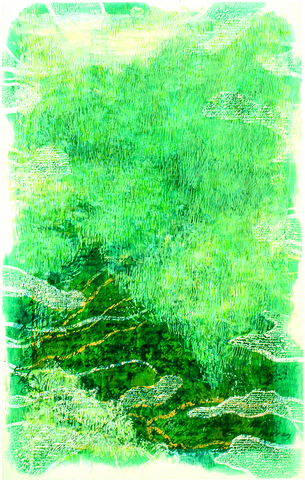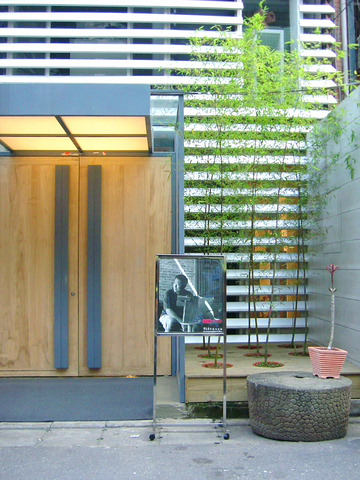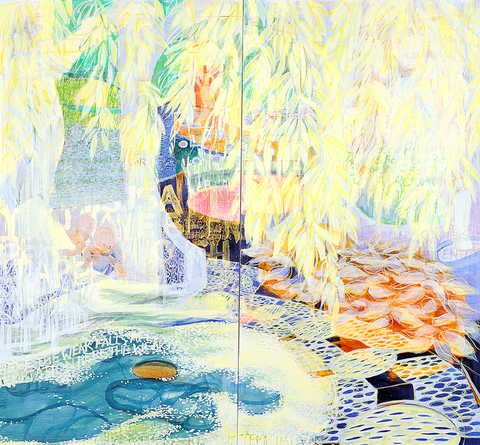When encountering avant-garde art for the first time, viewers often complain and spout uninspired comments such as, "my child could do better than that."
So for a refreshing change of pace, today's art journal features exhibitions of paintings that look like paintings, and sculpture that looks like sculpture. The theme that runs through the exhibited art is Modernism and in these collections shape, line and color take precedence over content, thus allowing viewers to delight in a purely visual feast.
The JiArt Gallery features the work of two artists. George Ho (

PHOTO COURTESY OF GEORGE HO
Kun (郭弘坤), mixes paintings and objects. The works' surfaces are heavily impastoed with creamy paint and accents of hand-written text or dabs of bright color. In one canvas, a cuckoo clock emerges from a painting while a small painted diagram shows a hand using a screwdriver.
Jun Youn Sculpture Gallery's first branch exhibits small sculptural pieces made of wood and bronze by Ju Ming (
Ju Ming, who was born in 1938, has his own museum in Chinshan (金山). He successfully merges shape and form with the gestures of taichi, creating an expression that is a seamless combination of East and West. The gallery caters to the private collector, so if you happen to have NT$1 million spare you may want to pick up one of his table-top wooden sculptures.

PHOTO: SUSAN KENDZULAK, TAIPEI TIMES
It is as rare as it is difficult for a son to follow in his famous father's footsteps. However, Ju Ming's son Ju Jun (朱雋) enjoys his father's unconditional support as an artist, so much so that the second branch of the Jun Youn Gallery recently opened with an exhibition of Jun's work. It is only a few doors down from the first branch.
At the first branch, shelves housing small tea pots act like room dividers, while Ju Ming's multicolored wooden sculptures are displayed together in groups. Unlike austere gallery spaces that leave an excess area of empty space around an art work, this space feels cozy with its grouping of figurative sculptures, antique furniture and ancient ceramics.
By contrast the son's space feels lighter and airier. Designed with a cool sleek interior, the place is calm and Zen-like. Not only are the spaces different in tone, so are the art works. On the surface, one can discern a slight similarity in that the same materials such as bronze and wood are used and that there is a similar handling of mass, but the similarities end there. Ju Jun favors certain motifs such as the resting Buddha and objects containing zippers.

For your information: What: Jun Youn Sculpture Gallery
Where:
Ju Ming's exhibition is at 12, Lane 362, Songjiang Rd (雋永一館, 台北市松江路362巷12號)
Ju Jun's exhibition is at 34, Lane 362, Songjiang Rd, Taipei (雋永二館,台北市松江路362巷34號)
Telephone:
(02) 2581 5486 for Ju Ming's exhibition;
(02) 2581 1280 for Ju Jun's
When: Ongoing
What: George Ho (侯玉書) and Kun (郭弘坤)
Where: JiArt Gallery, 30, Zhongshan N Rd Sec 3, Taipei, (中山北路3段 30號1樓)
Telephone: (02) 2595 2449
When: Until April 29

One of the biggest sore spots in Taiwan’s historical friendship with the US came in 1979 when US president Jimmy Carter broke off formal diplomatic relations with Taiwan’s Republic of China (ROC) government so that the US could establish relations with the People’s Republic of China (PRC). Taiwan’s derecognition came purely at China’s insistence, and the US took the deal. Retired American diplomat John Tkacik, who for almost decade surrounding that schism, from 1974 to 1982, worked in embassies in Taipei and Beijing and at the Taiwan Desk in Washington DC, recently argued in the Taipei Times that “President Carter’s derecognition

This year will go down in the history books. Taiwan faces enormous turmoil and uncertainty in the coming months. Which political parties are in a good position to handle big changes? All of the main parties are beset with challenges. Taking stock, this column examined the Taiwan People’s Party (TPP) (“Huang Kuo-chang’s choking the life out of the TPP,” May 28, page 12), the Democratic Progressive Party (DPP) (“Challenges amid choppy waters for the DPP,” June 14, page 12) and the Chinese Nationalist Party (KMT) (“KMT struggles to seize opportunities as ‘interesting times’ loom,” June 20, page 11). Times like these can

June 23 to June 29 After capturing the walled city of Hsinchu on June 22, 1895, the Japanese hoped to quickly push south and seize control of Taiwan’s entire west coast — but their advance was stalled for more than a month. Not only did local Hakka fighters continue to cause them headaches, resistance forces even attempted to retake the city three times. “We had planned to occupy Anping (Tainan) and Takao (Kaohsiung) as soon as possible, but ever since we took Hsinchu, nearby bandits proclaiming to be ‘righteous people’ (義民) have been destroying train tracks and electrical cables, and gathering in villages

Dr. Y. Tony Yang, Associate Dean of Health Policy and Population Science at George Washington University, argued last week in a piece for the Taipei Times about former president Ma Ying-jeou (馬英九) leading a student delegation to the People’s Republic of China (PRC) that, “The real question is not whether Ma’s visit helps or hurts Taiwan — it is why Taiwan lacks a sophisticated, multi-track approach to one of the most complex geopolitical relationships in the world” (“Ma’s Visit, DPP’s Blind Spot,” June 18, page 8). Yang contends that the Democratic Progressive Party (DPP) has a blind spot: “By treating any